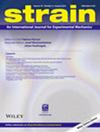Validation of the photomechanical spalling test in the case of non‐linear dynamic response: Application to a granite rock
IF 2.4
3区 材料科学
Q2 MATERIALS SCIENCE, CHARACTERIZATION & TESTING
引用次数: 3
Abstract
In this paper, the use of the virtual fields method for the identification of a strongly asymmetric compression–tension response of rock‐like materials under dynamic tensile loading is investigated. The photomechanical spalling set‐up is used, which induces an indirect tensile load in a non‐balanced sample, and the inertial component of the test is directly related to the measured dynamic stress with no previous assumption on the material behaviour. This experimental method provides a direct route to identifying the material asymmetric constitutive response in compression and tension under a uniaxial stress state as well as the material non‐linear response after tensile strength is reached. To validate this approach, the entire measurement chain for the case of a post‐peak response is investigated through simulated experiments that incorporate a damage model and synthetic grid images. Finally, the method is applied to the case of granite rock, namely, a Bohus granite, as to directly measure the material asymmetric compression–tension and the softening response after peak tensile stress.非线性动态响应情况下光刻剥落试验的验证:应用于花岗岩
本文研究了用虚拟场方法识别类岩材料在动态拉伸载荷下的强非对称压张响应。使用了照相剥落装置,它在非平衡样品中诱导间接拉伸载荷,并且测试的惯性分量与测量的动态应力直接相关,而没有先前对材料行为的假设。该实验方法为确定材料在单轴应力状态下压缩和拉伸时的非对称本构响应以及达到抗拉强度后的非线性本构响应提供了直接途径。为了验证这一方法,我们通过结合损伤模型和合成网格图像的模拟实验,研究了峰后响应情况下的整个测量链。最后,将该方法应用于花岗岩,即博胡斯花岗岩,直接测量材料的非对称压拉和峰值拉应力后的软化响应。
本文章由计算机程序翻译,如有差异,请以英文原文为准。
求助全文
约1分钟内获得全文
求助全文
来源期刊

Strain
工程技术-材料科学:表征与测试
CiteScore
4.10
自引率
4.80%
发文量
27
期刊介绍:
Strain is an international journal that contains contributions from leading-edge research on the measurement of the mechanical behaviour of structures and systems. Strain only accepts contributions with sufficient novelty in the design, implementation, and/or validation of experimental methodologies to characterize materials, structures, and systems; i.e. contributions that are limited to the application of established methodologies are outside of the scope of the journal. The journal includes papers from all engineering disciplines that deal with material behaviour and degradation under load, structural design and measurement techniques. Although the thrust of the journal is experimental, numerical simulations and validation are included in the coverage.
Strain welcomes papers that deal with novel work in the following areas:
experimental techniques
non-destructive evaluation techniques
numerical analysis, simulation and validation
residual stress measurement techniques
design of composite structures and components
impact behaviour of materials and structures
signal and image processing
transducer and sensor design
structural health monitoring
biomechanics
extreme environment
micro- and nano-scale testing method.
 求助内容:
求助内容: 应助结果提醒方式:
应助结果提醒方式:


